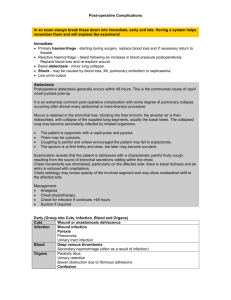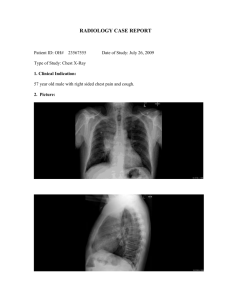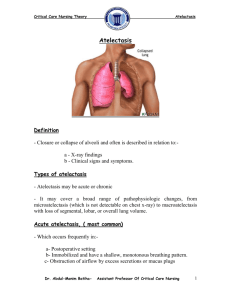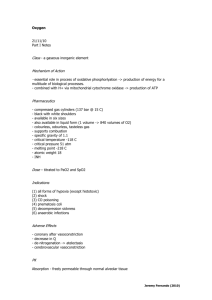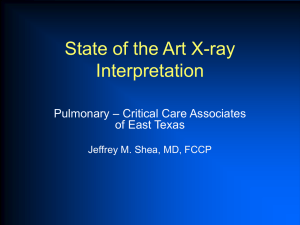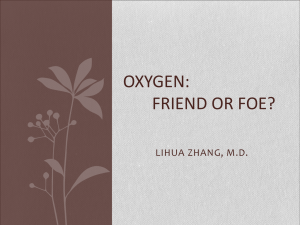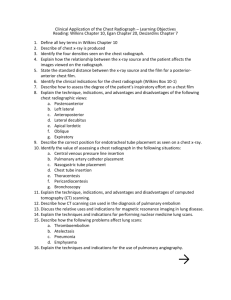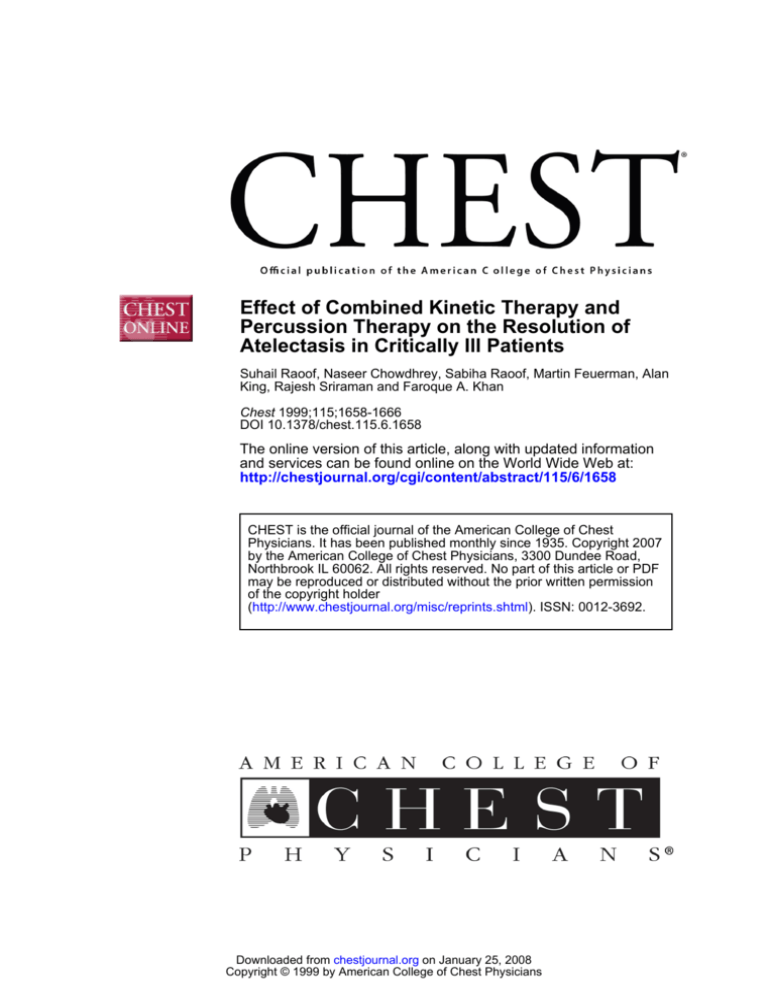
Effect of Combined Kinetic Therapy and
Percussion Therapy on the Resolution of
Atelectasis in Critically Ill Patients
Suhail Raoof, Naseer Chowdhrey, Sabiha Raoof, Martin Feuerman, Alan
King, Rajesh Sriraman and Faroque A. Khan
Chest 1999;115;1658-1666
DOI 10.1378/chest.115.6.1658
The online version of this article, along with updated information
and services can be found online on the World Wide Web at:
http://chestjournal.org/cgi/content/abstract/115/6/1658
CHEST is the official journal of the American College of Chest
Physicians. It has been published monthly since 1935. Copyright 2007
by the American College of Chest Physicians, 3300 Dundee Road,
Northbrook IL 60062. All rights reserved. No part of this article or PDF
may be reproduced or distributed without the prior written permission
of the copyright holder
(http://www.chestjournal.org/misc/reprints.shtml). ISSN: 0012-3692.
Downloaded from chestjournal.org on January 25, 2008
Copyright © 1999 by American College of Chest Physicians
Effect of Combined Kinetic Therapy and
Percussion Therapy on the Resolution
of Atelectasis in Critically Ill Patients*
Suhail Raoof, MD, FCCP; Naseer Chowdhrey, MD; Sabiha Raoof, MD;
Martin Feuerman, MS; Alan King; Rajesh Sriraman, MD; and
Faroque A. Khan, MBBS, FCCP
Background: Some critically ill patients have difficulty in mobilizing their respiratory secretions.
These patients can develop pulmonary atelectasis that may result in hypoxemia. There are some
data to show that atelectasis may be prevented by turning a patient from side to side utilizing
special beds.
Study objectives: To determine the role of kinetic therapy (KT) combined with mechanical
percussion (P) in the resolution of established atelectasis of the lungs and hypoxemia in critically
ill, hospitalized patients. (KT was defined as rotation of a patient along the longitudinal axis of
> 40° to each side continuously.)
Design: Prospective and randomized study (2:1 test to control group).
Patients: Twenty-four patients with respiratory failure, either mechanically ventilated or spontaneously breathing, who demonstrated segmental, lobar, or unilateral entire lung atelectasis
were studied.
Setting: Medical ICU and adult respiratory ward in a county hospital in New York.
Interventions: Seventeen patients were treated with KT combined with mechanical P using a KT
system (Triadyne Kinetic Therapy System; KCI; San Antonio, TX). Seven patients received
manual repositioning and manual P every 2 h. Both groups received similar conventional therapy
with inhaled bronchodilators and suctioning.
Results: Partial or complete resolution of atelectasis was seen in 14 of 17 patients (82.3%) in the
test group as compared with 1 of 7 patient (14.3%) in the control group. The median duration to
resolution of atelectasis was 4 days in the test group. Bronchoscopy was performed in 3 of 7
patients in the control group, but in none of the patients in the test group. A cost of $720 was
incurred per patient for utilizing the specialty beds for a mean duration of 4 days. An
improvement in oxygenation index occurred in the test group (change in baseline PaO2/fraction
of inspired oxygen from 207.4 6 106.7 mm Hg to 318 6 100.7 mm Hg) at the end of therapy,
while the control group showed a reduction over a similar duration of time (181.3 6 96.3 mm Hg
to 112 6 21.2 mm Hg).
Conclusions: KT and mechanical P therapy resulted in significantly greater partial or complete
resolution of atelectasis as compared with conventional therapy. There was a generalized trend
toward statistical significance in the improvement of oxygenation and a reduced need for
bronchoscopy in the group receiving KT and P therapy.
(CHEST 1999; 115:1658 –1666)
Key words: atelectasis; kinetic therapy; oxygenation; percussion
Abbreviations: APACHE 5 acute physiology and chronic health evaluation; DNR 5 do not resuscitate; KT 5 kinetic
therapy; MICU 5 medical ICU; P 5 mechanical percussion; Pao2/Fio2 5 ratio of partial pressure of oxygen in arterial
blood to fraction of oxygen in inspired gas; VW 5 ventilator ward
*From the Department of Medicine (Dr. Khan), State University of New York at Stony Brook, NY; Division of Pulmonary Diseases (Drs. Raoof and Chowdhrey), Nassau County
Medical Center (Mr. King), East Meadow, NY; Division of
Radiology (Dr. Sabiha Raoof), Jamaica Hospital Medical
Center, New York, NY; Winthrop University Hospital (Mr.
Feuerman), Mineola, NY; and the Division of Pulmonary and
Critical Care Medicine (Dr. Sriraman), Parkway Hospital,
Forest Hills, NY.
Supported by an unrestricted financial grant from Kinetic Concepts Inc, San Antonio, TX. None of the authors have any
financial interest in Kinetic Concepts, Inc.
Manuscript received April 30, 1998; revision accepted December
28, 1998.
Correspondence to: Suhail Raoof, MD, FCCP, Acting Chief,
Pulmonary Division, Director-Medical Intensive Care Unit, Nassau County Medical Center, 2201 Hempstead Turnpike, East
Meadow, NY 11554; e-mail: sraoof@ncmc.edu
1658
Clinical Investigations in Critical Care
Downloaded from chestjournal.org on January 25, 2008
Copyright © 1999 by American College of Chest Physicians
ill patients, unable to move spontaneC ritically
ously, are nursed in the supine position for
extended periods of time. This is in striking contrast
to normal human beings who, even during sleep,
change their position approximately every 11.6
min—a phenomenon described by Keane1 as “minimum physiological mobility requirement.” The deleterious effects of prolonged immobilization affect
the heart, vascular system, musculoskeletal system,
skin, and kidneys, despite repositioning every 2 h.2– 8
Significant effects may also occur in the respiratory system. Nosocomial pneumonia, pulmonary
thromboembolism, and hypoxemia may increase the
patient’s morbidity and mortality.9,10 Another pulmonary complication of immobility is atelectasis. In
the supine patient, the abdominal contents push in a
cephalad direction, thereby decreasing the functional residual capacity. The alveoli in the dependent
lung zones may close. Complete or partial closure of
these alveoli will result in lowering of their compliance; thus, a greater level of opening pressure would
be required to restore the patency of these alveoli. It
has been shown that immobility may also result in
accumulation of mucus in the dependent lung
zones.11,12 The most common segment of the lung to
develop atelectasis is the left lower lobe, possibly due
to compression by the heart in the supine position
and its poor drainage.
Whatever the mechanisms involved, atelectasis
results in development of a shunt with attendant
hypoxemia. The pooled and stagnant secretions may
act as a nidus for bacterial proliferation, culminating
in nosocomial pneumonia.
Treatment of atelectasis usually involves frequent
repositioning and suctioning of respiratory secretions, percussion (P) therapy, incentive spirometry,
or intermittent positive pressure breathing in the
spontaneously breathing patient. In the mechanically
ventilated patient, suctioning is more effective; application of positive end-expiratory pressure is of
doubtful efficacy. In patients with nonresolving atelectasis, bronchoscopic suctioning may be resorted to.
Bronchoscopy is an invasive and expensive procedure that may sometimes necessitate intubation,
especially in the severely hypoxemic patient with
inspissated mucus.
It is easier to prevent atelectasis than to treat it.
One of the newer modalities that has become available in the last few years is kinetic therapy (KT),
which is defined as the continuous turning of a
patient slowly along the longitudinal axis to $ 40°
onto each side.9 This therapy is delivered by using a
specialized bed that rotates from side to side, utilizing the minimum degree of turn. Several studies
have shown that KT can prevent the development of
atelectasis in the setting of trauma, quadriplegia, and
spinal cord injury.13–16
To our knowledge, no published studies have
addressed the value of KT and P in the resolution of
established pulmonary atelectasis. Addressing this
question was especially important to us, since our
medical ICU (MICU) and ventilator ward (VW)
admit a significant number of patients with atelectasis and respiratory failure from the affiliated 1,000bed geriatric center. The nurse to patient ratio of 1:7
to 10 in the VW does not usually allow frequent
manual repositioning and P of our patients. Many of
these elderly patients or their families do not allow
bronchoscopy to help in the resolution of atelectasis.
Materials and Methods
The protocol was approved by the Institutional Review Board
of Nassau County Medical Center, East Meadow, NY. New or
previously admitted patients to the MICU or VW of Nassau
County Medical Center between 1995 and 1997 were considered
eligible if they had respiratory failure and evidence of atelectasis
on chest radiographs. Patients could be breathing spontaneously
or mechanically ventilated. Patients or their designees who gave
written consent were randomized to either KT with P (test) or
manual repositioning (control). A 2:1 test to control randomization was done using slips with either test or control written on
them that were shuffled and sealed in envelopes.
KT was provided utilizing a KT system (Triadyne Kinetic
Therapy System; Kinetic Concepts, Inc; San Antonio, TX). The
angle of rotation was set to 45° on each side. A 5-min pause was
given at each of the three positions—right side down at 45°,
neutral position, left side down at 45°. The total number of
complete rotations (neutral-right-neutral-left-neutral) was four
per hour. A minimum duration of rotation was aimed at 18 h/24
h. The KT bed was programmed to administer P therapy at 9
beats/s. P was administered during the lateral rotation of the bed
for a total duration of 20 min every 4 h. To initiate P therapy, the
patient’s nurse switched on the P control button at four hourly
intervals. The control group was manually repositioned and
received percussion therapy every 2 h by the nursing staff. Both
groups received conventional therapy in the form of inhaled
bronchodilators, suctioning as needed, and other medications,
including antibiotics as deemed appropriate by the treating
physicians. Suctioning in the nonintubated patients was performed using the nasotracheal Silastic catheters attached to the
standard wall unit suction equipment.
The patients were followed up for the duration of time they
stayed on the MICU or VW, up to a maximum of 2 weeks. If the
patients were transferred from the MICU to the VW, they were
followed up for the remaining duration of the 2 weeks. The
primary variables monitored included the extent of atelectasis on
a portable chest radiograph at baseline (day 0) and on days 3, 7,
and 14. An independent chest radiologist who was blinded to the
test and control groups reviewed each chest radiograph and
determined atelectasis to be present using the following criteria:
patchy or dense areas of consolidation, without air bronchograms,
with evidence of loss of volume, following a segmental or lobar
distribution, usually appearing abruptly or over 1 to 2 days in a
manner more suggestive of atelectasis than pneumonia. In the
case of entire lung collapse, the cutoff sign of the main bronchus
was also looked for. The atelectasis was classified as segmental,
CHEST / 115 / 6 / JUNE, 1999
Downloaded from chestjournal.org on January 25, 2008
Copyright © 1999 by American College of Chest Physicians
1659
lobar, or unilateral whole lung. Resolution at each of the time
points applicable (days 3, 7, and 14) was noted as complete if the
entire area of atelectasis had resolved, partial if approximately
half of the area of atelectasis had resolved, and none if less than
one fourth of change in size was detected. After resolution of
atelectasis, any recurrence was noted over the 2-week study
period.
The other primary variable that was monitored was the Pao2/
fraction of inspired oxygen (Fio2) ratio at baseline and on days 3,
7, and 14 whenever possible. At least 30 min was allowed to
elapse after making any changes in the inspired Fio2 concentration before drawing an arterial blood gas sample. The arterial
blood sample was transported by the research coordinator to the
arterial blood gas analyzer within 5 to 10 min of drawing the
sample.
The need for bronchoscopy was determined by one of four
pulmonologists who were aware of the protocol. Bronchoscopy
was considered if the techniques utilized to bring about resolution of the atelectasis were not successful, if the patient’s
oxygenation was getting progressively worse (increasing the
likelihood of intubation and mechanical ventilation), and if the
patient or the family consented to the procedure. If present, “DO
NOT RESUSCITATE (DNR)” orders were rescinded during
and 24 h after the procedure, and complications of bronchoscopy
were treated as needed.
Demographic data were collected on all patients. The Acute
Physiology and Chronic Health Evaluation (APACHE II)17 score
was calculated at the time of randomization in the study. Other
variables noted included WBC count and temperature on days 0,
3, 7, and 14. The need for mechanical ventilation during the study
period and the lengths of stay in the MICU, VW, and hospital
were recorded. The patient’s final disposition (home, nursing
home, or death) was also noted.
The costs incurred with the use of the specialty bed were
obtained by multiplying the daily rental costs of the bed with the
average duration of time that it took for resolution of atelectasis.
The actual cost of performing a bronchoscopy was calculated
from time spent by the attending physician, pulmonary fellow,
and bronchoscopy nurse, and equipment and supplies used, in
addition to cost of sterilizing the bronchoscope.
Statistical analysis was done using Fisher’s Exact Test to
compare the degree of resolution between the test and the
control groups. Comparison of the Pao2/Fio2 ratio at baseline
between the test and control groups, and with each of the other
time points, was obtained utilizing the unpaired t tests. Withingroup analysis was done utilizing one-way repeated measures
analysis of variance. If the analysis of variance was significant, a
Tukey’s pairwise multiple comparison test (p , 0.05) was performed to determine which time points were significantly different from each other.
Results
A total of 32 patients were offered enrollment in
the protocol. Two patients died before consent could
be obtained, while three patients’ relatives refused to
give consent for the study (expressing concern at the
degree of rotation). The remaining two patients upon
intubation, at the time of enrollment in the study,
demonstrated radiographic resolution of atelectasis.
Twenty-five patients were considered eligible for the
study. Of these, 17 were randomized to the test
group and 8 to the control group. However, one
patient in the control group died within 24 h of
enrollment. Since a chest radiograph and follow-up
arterial blood gas determination could not be obtained prior to this patient’s death, she was not
included in the final analysis.
The demographic data of the patients are summarized in Table 1.
No significant differences were discerned in the
age, frequency of smoking, baseline WBC count, or
Pao2/Fio2 ratio between the two groups. The
APACHE II scores, calculated at the time of entry
into the study, were higher for the test group as
compared with the control group (p , 0.02). Thus,
the patients in the test group may have been slightly
sicker than the control group. The primary diagnosis
of the patients referred to the major clinical problem
of the patient during the 2 weeks of their enrollment
period.
Data analysis showed more patients with neurologic problems (strokes, subdural hematomas, intracranial hemorrhage) in the test group as compared
with the control group. Diagnoses included in the
category of respiratory disorders were mainly COPD
and pneumonia. No significant differences were seen
in the medication usage, including antibiotics in the
two groups, either before or during the clinical trial.
The percentage of patients intubated and mechanically ventilated at day 0 in the test group (47%) was
greater than when compared with the control group
(28.6%). This was because two of the remaining five
patients in the control group had advance directives
Table 1—Baseline Patient Information*
Patient Data
Control
KT With P
p Value
No.
7
17
Sex, No. (%)
Male
4 (57)
11 (65)
NS
Female
3 (43)
6 (35)
Age, yr, mean 6 SD
68 6 19
66 6 18
NS
Smoker, %
3
10
NS
Primary diagnosis, No. (%)
Pneumonia/respiratory
2 (28.5)
3 (17.5)
Sepsis/shock
1 (14.3)
2 (11.8)
Stroke/neurologic
2 (28.5)
9 (52.9)
NS
Trauma
1 (14.3)
1 (5.9)
S/P cardiopulmonary arrest
—
1 (5.9)
Congestive heart failure
1 (14.3)
1 (5.9)
12.3 3 103
10.8 3 103
NS
WBC (day 0), cells/mm3
6 SD
6 7.4
6 4.4
Pao2/Fio2
(day 0) 6 SD
181 6 96.3 207.4 6 106.7 NS
Intubated, No. (%)
2 (28.6)
8 (47.1)
NS
CPAP (nonintubated) (No. of 2/6.5 cm
3/7.3 cm
NS
patients/mean CPAP)
APACHE II score 6 SD
11 6 5
16 6 4
, 0.02
Glasgow Coma Scale 6 SD
11.3 6 2.9
8.8 6 4.6
NS
*S/P 5 status post; CPAP 5 continuous positive airway pressure;
NS 5 not significant.
1660
Clinical Investigations in Critical Care
Downloaded from chestjournal.org on January 25, 2008
Copyright © 1999 by American College of Chest Physicians
categorically specifying that mechanical ventilation
not be instituted in their individual cases.
The proportion of patients with atelectasis in the
test and control groups was similarly distributed
between the MICU and surgical ICUs and the VW.
The extent of atelectasis was similar in the test and
control groups at the initiation of the study (Table 2).
There was a trend toward more frequent lobar
atelectasis in the control group and entire lung
atelectasis in the test group. The test group had
complete or partial resolution of atelectasis in 14 of
17 patients (82.3%), while only 1 of 7 control patients
(14.3%) demonstrated this resolution (Fig 1). The
difference was highly statistically significant
(p 5 0.004). The median duration of resolution for
the test group was 4 days. Since only one of the
control patients underwent resolution, the numbers
were too small to calculate a median duration for this
group. The average length of time that KT and P
were administered to patients was 7.3 6 5.2 days. By
comparison, patients in the control arm received
conventional treatment for atelectasis for 9.5 6 3.8
days. The difference in duration of therapy was not
statistically significant.
None of the patients receiving KT and P required
a bronchoscopy for resolution of the atelectasis. Of
the three patients who failed to resolve their atelectasis with KT and P, bronchoscopy was not performed for the following reasons: refusal to give
consent (one), refusal to rescind DNR (one), and no
improvement with a prior bronchoscopy (one). In
the control arm, three patients underwent a bronchoscopy, and one demonstrated resolution of atelectasis without a bronchoscopy. Three remaining
patients did not undergo a bronchoscopy for the
following reasons: refusal to consent to procedure
(two) and refusal to rescind the DNR order prior to
the procedure (one).
Table 2—Atelectasis Data*
Control
n57
KT With
P
n 5 17
p Value
1.5 6 9
1.9 6 1.7
NS
1 (14.3%)
6 (85.7%)
0
5 (29.4%)
10 (58.8%)
2 (11.8%)
NS
Atelectasis Data
Duration of atelectasis prior to
enrollment, d, mean 6 SD
Extent of atelectasis
Entire lung
Lobar
Segmental
Degree of resolution
Complete
Partial
None
Days to resolution (median)
Recurrence of atelectasis
Bronchoscopy performed
*NS 5 not significant.
1
0
6
10
14.3% 4
82.3% 0.004
3
—
4
1/1
3/4
NS
3/7
0/17
, 0.02
}
}
Figure 1. Comparison of resolution of atelectasis between the
control and test group.
The actual cost of performing a bronchoscopy in
our institution varies from $290 to $320. This takes
into consideration the cost of disposable equipment
and medications used, the 1-h compensation of one
attending pulmonologist, and 11⁄2 h of a pulmonary
fellow and bronchoscopy nurse’s time, and the cost
of sterilizing the bronchoscope. While the cost in
private hospitals may be considerably higher, the
figures that we have quoted are fairly representative
of the costs incurred in a county or city hospital.
An apparent and significant improvement was
seen in the index of oxygenation of the test group
patients over the control patients. The Pao2/Fio2
ratio was not statistically different between the control group and the test group at day 0. There was a
significant difference between the test and control
group at all of the other time periods (days 3, 7, and
14) as indicated in Figure 2.
The p values for the four time periods are as
follows: p 5 0.58 (baseline); p 5 0.001 (day 3);
p 5 0.0007 (day 7); and p 5 0.03 (day 14). A withingroup analysis determined that the Pao2/Fio2 was
relatively flat over time for the control group
(p 5 0.42). However, for the test group, the Pao2/
Fio2 rises steadily with time with an overall p value
of p 5 0.0002.
No significant differences were observed in the
length of stay of patients in MICU, VW, or the
hospital. The mortality rate was not significantly
different between the test group and the control
group.
Discussion
This study suggests that a significantly higher rate
of partial or complete resolution of atelectasis may
be achieved in critically ill patients who receive both
KT and mechanical P. An improvement in oxygenation that was maintained over the study duration of
2 weeks and a reduced need for bronchoscopy were
CHEST / 115 / 6 / JUNE, 1999
Downloaded from chestjournal.org on January 25, 2008
Copyright © 1999 by American College of Chest Physicians
1661
Figure 2. Comparison of oxygenation index between the control and test group over a 2-week study
period.
also seen. To our knowledge, this is the first study
looking at KT and P as a treatment modality for
radiographically evident atelectasis.
The critically ill patient who is unable to move or
cough effectively has multiple reasons to develop
atelectasis and impaired mucociliary clearance.3,18 –21
Atelectasis has been reported in 74% of patients with
acute spinal cord injury,22–24 85% with neuromuscular diseases,25 up to 90% of patients who have
undergone cardiac surgery, and 20 to 30% of patients
after upper abdominal surgery.26 –29
Atelectasis may be visible radiographically as segmental, lobar, or entire lung. Alternately, it may not
be detected radiographically—a condition referred
to as microatelectasis.30,31 It has also been postulated, although not proven, that atelectasis may
predispose to pneumonia.32–34
It has been observed that when air bronchograms
are seen in the atelectatic lung, resolution is delayed.35 Atelectasis persistent beyond 48 h usually
necessitates aggressive therapy.34 The usual treatment modalities include positioning for postural
drainage, manual P, suctioning, incentive spirometry, maximal lung inflation,36 intermittent positive
pressure breathing,37 and bronchoscopy.38 – 40 Two
other less widely used techniques, one deploying a
curved-tip catheter to suction the upper lung lobes41
and another selectively insufflating air intrabronchially in collapsed segments to expand them,42,43 have
been described.
The efficacy of chest physical therapy for resolving
atelectasis, positioning postural drainage, P, suction-
ing, and lung inflation for resolving atelectasis parallels that of bronchoscopy.35,38,44,45 Dettenmeier et
al46 showed an improvement in the oxygenation
indexes, and radiographic findings of patients with
atelectasis who received both chest physiotherapy
and KT as compared with those who received only
KT. Stiller et al47 demonstrated improvement in the
rate of resolution of lobar atelectasis when positioning and vibrations were combined with hyperinflation and suctioning (as compared with hyperinflation
and suctioning alone). Based on this information, we
chose to use both KT and P to treat atelectasis in our
patient population.
It is recommended that chest physiotherapy be
carried out at least every 2 h in critically ill patients
with atelectasis.36,48 Animal experiments, further,
showed that turning intervals of 30 min were more
effective in preventing hypoxemia and atelectasis
than hourly position changes. Hourly position
changes were found to be better than no mobilization.3
However, a protocol of manual repositioning and
P every 1 to 2 h has several drawbacks. It blocks off
a significant segment of nursing time in the critical
care areas. Nursing time accounts for 44% of costs
incurred in caring for patients in the MICUs.49 Back
injuries are occasionally sustained by the nursing
staff in the process of positioning patients. In addition, many of our ICU patients who fail to respond to
weaning and are otherwise in hemodynamically stable condition, are sent to the VW. Some of these
patients develop atelectasis. In the VW, where the
1662
Clinical Investigations in Critical Care
Downloaded from chestjournal.org on January 25, 2008
Copyright © 1999 by American College of Chest Physicians
patient to nurse ratio is 7:1, a labor-intensive protocol for treating atelectasis is practically not feasible.
Hence, we were interested in evaluating the new
specialty beds that have the capability of providing
KT and P to our patient population.
Since its introduction in 1939, the rigid Stryker
frame beds were used widely until 1980 for acute
spinal cord injury patients. Refinements of this bed
followed with the development of a kinetic treatment
table. The kinetic treatment table rotates a patient
from side to side by $ 40° along the longitudinal axis
at a speed of rotation of half a degree per second.
This slow speed of rotation prevents stimulation of
the vestibular apparatus.50 The angle of rotation
needs to be monitored carefully. In the study of
Traver et al,51 no significant difference in length of
stay, duration of ventilation, or incidence of pneumonia was discerned. One of the plausible explanations put forth was that a mean angle of rotation of
25.5° was achieved in the ICU patients. In our
protocol, we used an angle of rotation of 45° on each
side. The duration of rotation per day is not well
defined. Most of the studies using these specialty
beds used a duration of rotation of at least 10 to 16
h/d.
There is very little information regarding the
appropriate frequency and duration of P therapy.
Imle52 recommended frequencies ranging from 1.7
to 6 cycles per second. Others have proposed slower
or faster frequencies, depending on their own personal experience. Although the frequency of P was
assuredly different between the test and control
groups, the purpose was to study the effects of
manual and mechanical P in a real-life situation—
where it would be difficult to regulate the exact
frequency of the manual Ps. How frequently to
administer P remains equally nebulous. In the physiotherapy regimen used by Stiller et al,47 P was
administered on an hourly basis to patients with
lobar atelectasis. However, since P has to be
switched on manually each time, we chose an interval of 4 h that we believed was more practical in our
setting.
The patients in the test group had a higher
APACHE II score and may have been sicker than
the control subjects. Since the Pao2/Fio2 ratio was
similar between the test and control groups, it may
be inferred that the test group had more severe
nonpulmonary disorders. Although the former demonstrated a trend toward more frequent intubation
and mechanical ventilation, statistical significance
was not achieved. Suctioning can be carried out
more effectively in the intubated patients. However,
we do not believe that this was the major reason for
greater resolution of atelectasis in the test group.
The distinction between atelectasis, pleural effu-
sion, and pneumonia on chest radiographs may be
difficult to make. The sign on chest radiograph given
most credence was that of volume loss. On occasions,
patients demonstrated both loss of volume on chest
radiographs and had concomitant fever and/or leukocytosis. Prior studies have demonstrated that fever
may be an accompaniment of atelectasis.25,53 In such
cases, the rate of development or resolution of
pulmonary infiltrates was used to decide if atelectasis
was more likely than pneumonia or vice versa.
Most of the patients receiving conventional treatment and KT and P developed lobar atelectasis.
Complete lung atelectasis and segmental atelectasis
together accounted for , 50% of the cases in each
group. Complete resolution of atelectasis occurred in
10 of 17 patients (58.8%) in the KT and P group as
compared with 1 of 7 in the control group (14.3%).
An additional 4 of 17 patients (23.5%) receiving KT
and P showed partial resolution of atelectasis. Thus,
significant improvement in atelectasis was seen in
. 80% of patients receiving KT and P in contrast to
, 20% of patients who received conventional therapy.
Examining the subset of patients with entire lung
atelectasis, there was complete resolution seen in
three of five patients in the test group and one of one
patient in the control group. The chest radiograph of
a patient in the test group showing entire lung
atelectasis is depicted in Figure 3, top, A. A follow-up chest radiograph, obtained 24 h after the
institution of KT and P, demonstrates partial resolution of atelectasis (Fig 3, bottom, B). Those in the
test group who showed complete resolution of atelectasis took a mean of 3 days for resolution. Thus, if
complete resolution was to occur, it was likely to
occur relatively early in the course of treatment. A
plausible explanation may be that most of these
patients had a mucus plug in the central airways,
which, with positioning and P, could be suctioned
out or dislodged. Indeed, four of five patients in the
test group and the one patient in the control group
with entire lung atelectasis showed a bronchus cutoff
sign. For the patients in the KT and P arm with lobar
atelectasis, complete resolution was seen in six patients within a mean duration of 4.8 days. In this
same subgroup, partial resolution occurred in one
patient.
Patients receiving KT and P who developed recurrence of atelectasis during the study period tended to
be older (mean age, 72.6 years), had a higher
Glasgow Coma Scale (mean value, 13), demonstrated atelectasis for a longer duration of time
before enrollment (mean, 8.3 days), and had excessive respiratory secretions from underlying pulmonary disease (COPD and pneumonia). In contrast to
patients with entire lung atelectasis or segmental
CHEST / 115 / 6 / JUNE, 1999
Downloaded from chestjournal.org on January 25, 2008
Copyright © 1999 by American College of Chest Physicians
1663
Figure 3. Top, A: left lung atelectasis in a patient in the test
group on day 0. Bottom, B: repeated chest radiograph of the same
patient 24 h after administration of KT and P. The radiograph
demonstrates partial resolution of atelectasis.
atelectasis, all three patients in the test group who
failed to show significant resolution had lobar atelectasis. Two of the three patients whose conditions
failed to improve were not intubated.
The patients in the test group showed a very
significant improvement in their oxygenation as compared with the control group. The index of oxygenation chosen was the Pao2/Fio2 ratio. This index is
simple to calculate, takes inspired oxygenation in
consideration, and remains accurate, unless there are
large fluctuations in the Paco2. Most of the patients
had relatively small variations in the Paco2 in our
series. The Pao2/Fio2 on day 0 was not statistically
different between the test and control groups. An
improvement in the Pao2/Fio2 was noted as early as
day 3 in the test group and was sustained until day
14. A significant improvement in the Pao2/Fio2 ratio
was seen in the test group at each of the follow-up
points (days 3, 7, and 14) when compared with the
baseline Pao2/Fio2 ratios. The values for P/F ratio
for control and test respectively were as follows: day
3: 144.6 6 42.6 vs 257.8 6 103.4; day 7: 101 6 21.9
vs 311.1 6 93.0; and day 14: 112 6 21 vs 318 6 100.
In addition, at each of the time points indicated
above, the P/F ratio was significantly higher for the
test group as compared with the control group.
These data conform to the existing data showing a
significant improvement in the oxygenation indexes
with KT.54 –56 The greatest improvement in the
oxygenation index was observed at about 24 h after
radiographic partial or complete resolution of atelectasis. In a study by Bein et al,57 10 patients with
severe, acute respiratory failure and mean Pao2/Fio2
of 169 6 7 mm Hg were placed on a rotational bed
(RotoRest) and studied. The ventilation/perfusion
ratio was determined using multiple inert gas techniques. It was concluded that KT reduces ventilation/perfusion mismatch in patients with acute lung
injury.57 In another prospective study by Hörmann
and colleagues,58 12 patients with severe ARDS were
rotated by 62° on each side using KT. The Fio2
requirement decreased from 0.8 at baseline to 0.35
on day 6 of the study. Concomitantly, the Pao2
increased from a baseline of 99 mm Hg to 110 mm
Hg. In a study done in the pediatric population,
Jaimovich et al59 studied five children with acute
respiratory failure requiring mechanical ventilation
and Fio2 $ 0.5. Such patients were assigned to
continuous KT (up to 40° angle on each side). They
demonstrated an improvement in Pao2 that allowed
them to reduce to Fio2 to , 0.5 within 40 h of
hospital admission. Murai and Grant,60 utilizing an
oscillating bed, found a significant reduction in the
duration of oxygen supplementation in newborn
infants with different respiratory disorders.
It was not possible to do a cost analysis on our
patient population. Excluding one outlier, our patients had an average length of stay in the hospital of
47.1 6 44.9 days in the test group and 18.7 6 8.4
days in the control group. These patients had multiple medical problems and thus had protracted hospital stays. Nonmedical issues, such as delay in
placement of patients in nursing homes, also influenced the length of stay of four of the test patients.
Therefore, addressing an acute problem that developed in this patient population for up to 2 weeks was
not likely to bring about significant cost savings.
Bronchoscopy for atelectasis is resorted to in our
hospital if there is failure of resolution of atelectasis
in 2 to 3 days with conservative measures (suctioning, physical therapy including manual P, and inhaled bronchodilators) or the development of hypoxemia from the atelectasis necessitating high Fio2
concentrations. The need for bronchoscopy was determined by one of the pulmonologists who followed
1664
Clinical Investigations in Critical Care
Downloaded from chestjournal.org on January 25, 2008
Copyright © 1999 by American College of Chest Physicians
these broad indications. However, he was aware of
the protocol. This may have introduced a bias in his
decisions. In our study, none of the 17 test patients
underwent a bronchoscopy, in contrast to 3 of 7
control patients who required a bronchoscopy. Bronchoscopy was considered in the three test patients
whose atelectasis failed to resolve with KT and P.
However, for the reasons outlined earlier, it was
deferred. Assuming that a bronchoscopy is done in
all patients with nonresolving atelectasis, it can be
projected from our data that in 100 patients with
atelectasis, roughly 68 bronchoscopies may be
avoided by utilizing KT and P.
One of the observations made during our study
was that manual repositioning and physical therapy
were not carried out in the non-ICU areas every 2 h
as ordered. Nonadherence to physicians’ orders for
frequent treatment or therapeutic interventions has
been commonly reported.61 Therefore, it is possible
that the rate of resolution of atelectasis may have
been higher in the VW if strict compliance with the
protocol was enforced. However, we were more
interested in finding out what happens in a real-life
situation.
In summary, we report beneficial effects on the
resolution of atelectasis, improvement of oxygenation, and reduced need for bronchoscopy in critically ill patients. We recommend using KT and P
therapy in comatose patients without severe hypoxemia. It may also be considered a noninvasive treatment modality in patients with atelectasis and severe
hypoxemia who refuse a bronchoscopy or will not
allow intubation during a bronchoscopy if a complication were to arise.
10
11
12
13
14
15
16
17
18
19
20
21
22
23
24
References
1 Keane FX. The minimum physiological mobility requirement
for man supported on a soft surface. Paraplegia 1978 –1979;
16:383–389
2 Chobanian AV, Lille KD, Tercyak A, et al. The metabolic and
hemodynamic effects of prolonged bed rest in normal subjects. Circulation 1974; 49:551–559
3 Ray JF, Yost L, Moallem S, et al. Immobility, hypoxemia, and
pulmonary arteriovenous shunting. Arch Surg 1974; 109:537–
541
4 Harper CM, Lyles YM. Physiology and complications of bed
rest. J Am Geriatr Soc 1988; 36:1047–1054
5 Corcoran PJ. Use it or lose it—the hazards of immobility.
West J Med 1991; 154:536 –538
6 Steinberg FU, Dean BZ. Physiatric therapeutics: management of the immobilized patient. Arch Phys Med Rehabil
1990; 71:S281–S282
7 Kudsk KA, Fabian TC, Baum S, et al. Silent deep vein
thrombosis in immobilized multiple trauma patients. Am J
Surg 1989; 158:515–519
8 Appell HJ. Muscle atrophy following immobilization: a review. Sports Med 1990; 10:42– 45
9 Dobson PMS, Edbrooke DL, Reilly CS. The role of kinetic
25
26
27
28
29
30
31
32
therapy in intensive care: the effects of immobilization and
some possible solutions. Br J Intensive Care 1993; 3:370 –374
Hess D, Agarwal NN, Myers CL. Positioning, lung function,
and kinetic bed therapy. Respir Care 1992; 37:181–197
Gamsu G, Singer MM, Vincent HH, et al. Post-operative
impairment of mucus transport in the lung. Am Rev Respir
Dis 1976; 114:673– 679
Pavia D. Mucocilliary clearance at night— effect of physical
activity, posture, and circadian rhythm in nocturnal asthma.
No. 73. Barnes PJ, Levy J, eds. London, UK: Royal Society of
Medicine, 1984
Gentilello L, Thompson DA, Tonnesen AS, et al. Effect of a
rotating bed on the incidence of pulmonary complications in
critically ill patients. Crit Care Med 1988; 16:783–786
Narayan RK, Robertson CS, Contant CF. A prospective
randomized trial of kinetic therapy in neurosurgical patients.
Presented at the Second Kinetic Therapy Seminar, San
Antonio, TX, 1988
Rines HD, Harris RC. Pulmonary complications of acute
spinal cord injuries. Neurosurgery 1987; 21:193–196
Brackett TO, Condon N. Comparison of the wedge turning
frame and kinetic treatment table in the treatment of spinal
cord injury patients. Surg Neurol 1984; 22:53–56
Knaus W, Draper E, Wagner D, et al. APACHE-II: a severity
of disease classification system. Crit Care Med 1985; 13:818 –
829
Leith DE. The development of cough. Am Rev Respir Dis
1985; 141(suppl):39 – 42
Mossberg B, Camner P. Mucociliary transport and cough as
clearance mechanisms in obstructive lung disease. Eur J
Respir Dis 1980; 111(suppl):18 –20
Newhouse MT. Factors affecting sputum clearance [abstract]. Thorax 1973; 28:267
King M. Rheological requirements for optimal clearance of
secretions: ciliary transport versus cough. Eur J Respir Dis
1980; 110(suppl):39 – 45
Fishburn MJ, Marino RJ, Ditunno JF Jr. Atelectasis and
pneumonia in acute spinal cord injury. Arch Phys Med Rehail
1990; 71:197–200
Carter RE. Unilateral diaphragmatic paralysis in spinal cord
injury patients. Paraplegia 1980; 18:267–273
Axen K, Pineda H, Shunfenthal I, et al. Diaphragmatic
function following cervical cord injury: neurally mediated
improvement. Arch Phys Med Rehabil 1985; 66:219 –222
Schmidt-Nowara WW, Altman AR. Atelectasis and neuromuscular respiratory failure. Chest 1984; 85:792–795
Warner DO, Warner MA, Ritman EL. Atelectasis and chest
wall shape during halothane anesthesia. Anesthesiology 1996;
85:49 –59
Ejlertsen T, Nielsen PH, Jepsen S, et al. Early diagnosis of
post operative pneumonia following upper abdominal surgery. Acta Chir Scand 1989; 154:93–98
Hall JC, Tarala RA, Hall JL, et al. A multivariate analysis of
the risk of pulmonary complications after laparotomy. Chest
1991; 99:923–927
Tisi GM. Preoperative evaluation of pulmonary function:
validity, indications, and benefits. Am Rev Respir Dis 1979;
119:293–310
Goodman LR. Postoperative chest radiograph: I. Alterations
after abdominal surgery. AJR Am J Roentgenol 1980; 134:
533–541
Beydon L, Saada M, Liu N, et al. Can portable chest x-ray
examination accurately diagnose lung consolidation after major abdominal surgery? Chest 1992; 102:1697–1703
Johnson NT, Pierson DJ. The spectrum of pulmonary atelectasis: pathophysiology, diagnosis and therapy. Respir Care
1986; 31:1107–1120
CHEST / 115 / 6 / JUNE, 1999
Downloaded from chestjournal.org on January 25, 2008
Copyright © 1999 by American College of Chest Physicians
1665
33 Scuderi J, Olsen GN. Respiratory therapy in the management
of postoperative complications. Respir Care 1989; 34:281–291
34 Peper EA, Conrad SA. Respiratory complications of surgery and
thoracic trauma. In: George R, Light R, Matthay M, et al, eds.
Chest medicine: essentials of pulmonary and critical care medicine. Baltimore, MD: Williams & Wilkins, 1990; 453– 473
35 Marini JJ, Pierson DJ, Hudson LD. Acute lobar atelectasis: a
prospective comparison of fiberoptic bronchoscopy and respiratory therapy. Am Rev Respir Dis 1979; 119:971–978
36 Ciesla ND. Chest physical therapy for patients in the intensive care unit. Phys Ther 1996; 76:609 – 625
37 Brooks-Brunn JA. Postoperative atelectasis and pneumonia.
Heart Lung 1995; 24:94 –115
38 Olopade CO, Prakash UBS. Bronchoscopy in the critical care
unit. Mayo Clin Proc 1989; 64:1255–1263
39 Turner JS, Willcox PA, Hayhurst MD, et al. Fiberoptic bronchoscopy in the intensive care unit—a prospective study of 147
procedures in 107 patients. Crit Care Med 1994; 22:259 –264
40 Barrett CR. Flexible fiberoptic bronchoscopy in the critically
ill patient. Chest 1978; 73:746 –749
41 Kubota Y, Toyoda Y, Kubta H, et al. Treatment of atelectasis
of upper lung lobes. Anaesthesia 1990; 45:842– 845
42 Susini G, Sisillo E, Bortone F, et al. Postoperative atelectasis
reexpansion by selective insufflation through a balloon tipped
catheter. Chest 1992; 102:1693–1696
43 Haenel JB, Moore FA, Moore EE, et al. Efficacy of selective
intrabronchial air insufflation in acute lobar collapse. Am J
Surg 1992; 164:501–505
44 Wong JW, Keens TG, Wannamaker EM, et al. Effects of
gravity in tracheal transport rates in normal subjects and in
patients with cystic fibrosis. Pediatrics 1977; 60:146 –152
45 Mackenzie CF. Physiological changes following chest physiotherapy. In: Mackenzie CF, ed. Chest physiotherapy in the
intensive care unit. 2nd ed. Baltimore, MD: Williams &
Wilkins, 1989; 240 –242
46 Dettenmeier PA, Homnenich P, Matheny N, et al. Effects of
chest physiotherapy in patients on the Roto-kinetic treatment
table. Am Rev Respir Dis 1984; 138:A132
47 Stiller K, Geake T, Taylor J, et al. Acute lobar atelectasis: a
comparison of two chest physiotherapy regimens. Chest 1990;
98:1336 –1340
48 Chulay M, Brown J, Summer W. Effect of postoperative
immobilization after coronary artery bypass surgery. Crit
Care Med 1982; 10:176 –179
49 Krieger BP. Economics of ventilator care. In: Tobin MJ, ed.
50
51
52
53
54
55
56
57
58
59
60
61
Principles and practice of mechanical ventilation. New York,
NY: McGraw-Hill, 1994; 1221–1231
Bennett-Candini S. The kinetic treatment table: a new approach to bed rest. Orthop Nurs 1985; 4:61–70
Traver GA, Tyler ML, Hudson LD, et al. Continuous oscillation: outcome in critically ill patients. J Crit Care 1995;
10:97–103
Imle PC. Percussion and vibration. In: Mackenzie CF, ed.
Chest physiotherapy in the intensive care unit, 2nd ed.
Baltimore, MD: Williams & Wilkins, 1989; 134 –135, 138,
141, 146
Roberts J, Barnes W, Pennock M, et al. Diagnostic accuracy
of fever as a measure of pulmonary complications. Heart
Lung 1988; 17:166 –169
Sriraman R, Chowdhrey N, Grant MM, et al. Impact of
kinetic therapy of 45° on the oxygenation of mechanically
ventilated patients [abstract]. Chest 1996; 110(suppl):1S
Nelson LD. The effects of the roto rest kinetic bed on gas
exchange and hemodynamics in critically ill patients. In:
Green BA, Summer WR, eds. Continuous oscillation therapy:
research and practical applications. Miami, FL: University of
Miami Press, 1986
Pape HC, Regel G, Borgmann W, et al. The effect of kinetic
positioning on lung function and pulmonary haemodynamics
in post-traumatic ARDS: a clinical study. Injury 1994; 25:
51–57
Bein T, Reber A, Stjernström H, et al. Effects of continuous
rotational therapy on ventilation-perfusion inequality in severe respiratory failure. Paper presented at: Society of Critical
Care Medicine Meeting; February 5–9, 1996; New Orleans,
LA
Hörmann C, Baum M, Putensen C. Effect of kinetic therapy
in patients with severe adult respiratory distress syndrome.
Paper presented at: Society of Critical Care Annual Meeting;
January 30 –February 3, 1994; Orlando, FL
Jaimovich DG, Sulayman RF, Husayni TS. Kinetic therapy in
critically ill pediatric patients with acute respiratory failure
[abstract]. Pediatr Res 1995; 37:48A
Murai DT, Grant JW. continuous oscillation therapy improves the pulmonary outcome of intubated newborns: results of a prospective, randomized, controlled trial. Crit Care
Med 1994; 22:1147–1154
Yarnal JR, Helbock M, Schwiter EJ, et al. Rotorest kinetic
treatment table (Rotobed) in patients with acute hypoxemic respiratory failure. In: Green BA, Summer WR, eds.
Continuous oscillation therapy: research and Practical
Applications. Miami, FL: University of Miami Press, 1986;
121–130
1666
Clinical Investigations in Critical Care
Downloaded from chestjournal.org on January 25, 2008
Copyright © 1999 by American College of Chest Physicians
Effect of Combined Kinetic Therapy and Percussion Therapy on the
Resolution of Atelectasis in Critically Ill Patients
Suhail Raoof, Naseer Chowdhrey, Sabiha Raoof, Martin Feuerman, Alan
King, Rajesh Sriraman and Faroque A. Khan
Chest 1999;115;1658-1666
DOI 10.1378/chest.115.6.1658
This information is current as of January 25, 2008
Updated Information
& Services
Updated information and services, including
high-resolution figures, can be found at:
http://chestjournal.org/cgi/content/full/115/6/1658
References
This article cites 48 articles, 9 of which you can access
for free at:
http://chestjournal.org/cgi/content/full/115/6/1658#BIBL
Citations
This article has been cited by 4 HighWire-hosted
articles:
http://chestjournal.org/cgi/content/full/115/6/1658
Permissions & Licensing
Information about reproducing this article in parts
(figures, tables) or in its entirety can be found online at:
http://chestjournal.org/misc/reprints.shtml
Reprints
Information about ordering reprints can be found online:
http://chestjournal.org/misc/reprints.shtml
Email alerting service
Receive free email alerts when new articles cite this
article sign up in the box at the top right corner of the
online article.
Images in PowerPoint format Figures that appear in CHEST articles can be
downloaded for teaching purposes in PowerPoint slide
format. See any online article figure for directions.
Downloaded from chestjournal.org on January 25, 2008
Copyright © 1999 by American College of Chest Physicians

